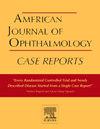通过结膜淋巴通道引流结膜下出血
Q3 Medicine
引用次数: 0
摘要
目的探讨眼淋巴受累在结膜下出血引流和治疗中的作用。方法我们报告一例63岁的白人女性,在白内障手术中使用结膜下麻醉剂后出现结膜下出血。术中使用光学相干断层扫描对深、中结膜tenon空间内的这些结构进行成像。结果结膜下出血可见,出血部位附近出现囊状充血结构。术中光学相干断层扫描证实了血液存在于结构中,这些结构包含让人想起瓣膜小叶的分区,表明它们起源于淋巴。结膜下出血在术后迅速消退。结论结膜下出血可在结膜淋巴管的辅助下得到解决。我们的研究结果证实,淋巴结构可能在协助结膜下间隙清除大分子方面发挥着被低估的作用。本文章由计算机程序翻译,如有差异,请以英文原文为准。
Drainage of subconjunctival hemorrhage through conjunctival lymphatic pathways
Purpose
To demonstrate the role of ocular lymphatic involvement in aiding the drainage and resolution of subconjunctival hemorrhage.
Methods
We present the case of a 63-year-old Caucasian female who developed a subconjunctival hemorrhage following the administration of a subconjunctival anesthetic during cataract surgery. Intraoperative optical coherence tomography was utilized to image these structures within the deep and middle conjunctival-Tenon's space.
Results
Subconjunctival hemorrhage was visualized and saccular blood-filled structures developed adjacent to sites of hemorrhage. Intraoperative optical coherence tomography confirmed the presence of blood within structures containing partitions reminiscent of valvular leaflets, indicating their lymphatic origin. Rapid resolution of the subconjunctival hemorrhage was noted during the immediate postoperative period.
Conclusion
Subconjunctival hemorrhage may have its resolution assisted by conjunctival lymphatic vessels. Our findings confirm that lymphatic structures may play an under-appreciated role in assisting the clearance of macromolecules from the subconjunctival space.
求助全文
通过发布文献求助,成功后即可免费获取论文全文。
去求助
来源期刊

American Journal of Ophthalmology Case Reports
Medicine-Ophthalmology
CiteScore
2.40
自引率
0.00%
发文量
513
审稿时长
16 weeks
期刊介绍:
The American Journal of Ophthalmology Case Reports is a peer-reviewed, scientific publication that welcomes the submission of original, previously unpublished case report manuscripts directed to ophthalmologists and visual science specialists. The cases shall be challenging and stimulating but shall also be presented in an educational format to engage the readers as if they are working alongside with the caring clinician scientists to manage the patients. Submissions shall be clear, concise, and well-documented reports. Brief reports and case series submissions on specific themes are also very welcome.
 求助内容:
求助内容: 应助结果提醒方式:
应助结果提醒方式:


